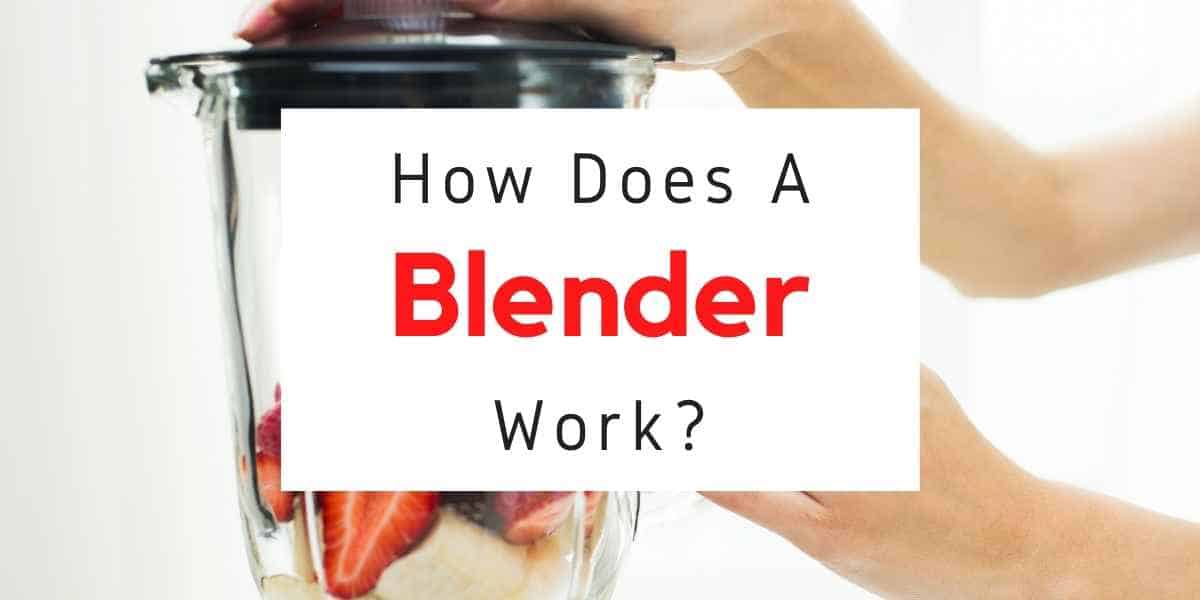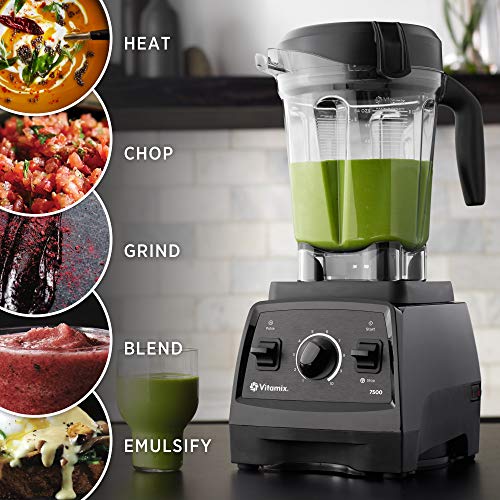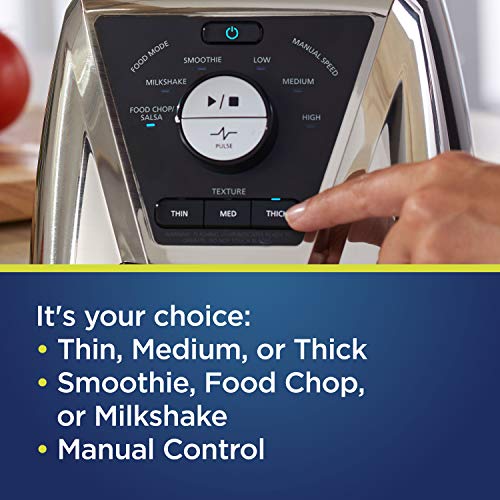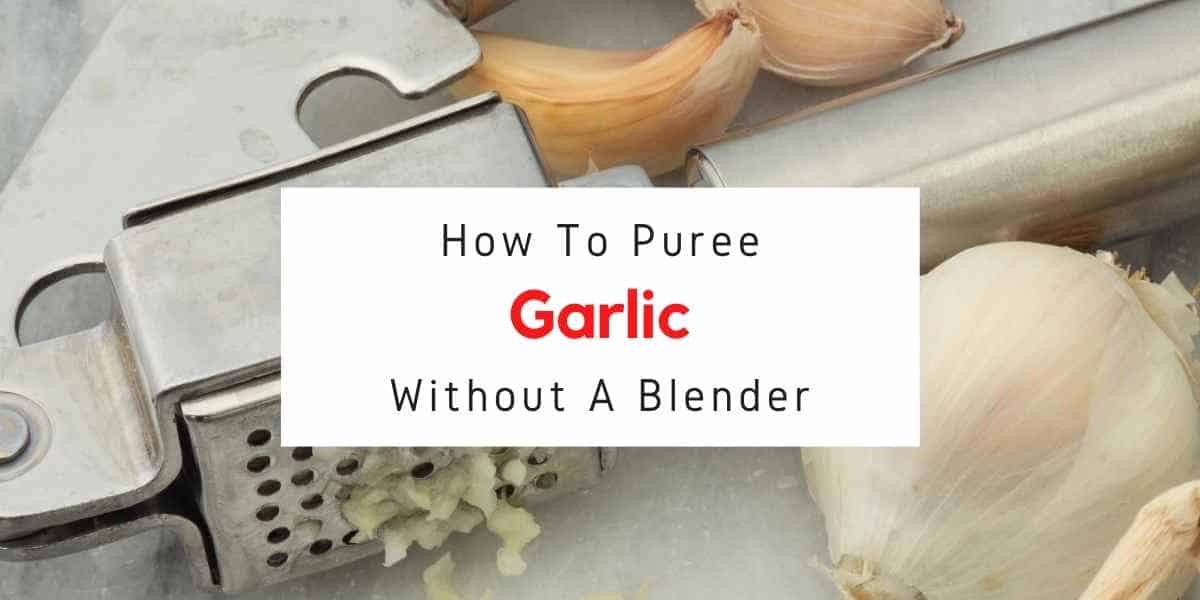The one thing I can’t live without in the kitchen is my blender, which makes smoothies and shakes.
It comes in handy for anything that needs a little mixing.
A blender is a kitchen appliance that blends food and ice to create smoothies, milkshakes, sauces, frappes, and more.
It consists of a container or jar with blades mounted on the bottom of it.
These appliances are considered to be multipurpose because they can chop, grate, slice, mix and blend all in one unit.
The device consists of three parts: the base that holds the motor; the pitcher or container where you place your ingredients; and a lid with an opening for adding food while it’s blending.
But, how does a blender work? Let’s find out how a blender functions in this post.
History Of Blenders

Blenders have been used to make malted milk drinks since the early 1900s.
Doctors prescribed these concoctions to help patients build up their strength.
From soda fountains to ice cream makers, they were able to make more than just sodas and flavorings.
The blender has been around for a long time, but it wasn’t until 1937 that the device found widespread popularity as a means to mix up cocktails.
Fred Waring, a well-known big band leader and TV/radio star with the “Fred Waring and the Pennsylvanians” group, became enamored with blenders after he was prescribed a raw food diet to treat ulceration.
It is said that one of his reasons for this was due to wanting to drink while on his diet!
The founder had a knack for coming up with big ideas and executing them in creative ways.
For example, after founding his own company to make mixers, he went on to develop and manufacture an improved version of blenders which were marketed under the name “Miracle Mixers.”
These devices became wildly popular among those looking to enjoy delicious cocktails at home.
But it was renamed the Waring Blender when Jonas Salk used it to develop a vaccination for polio.
What Are Blenders Used For?
Blenders are a versatile and useful tool in the kitchen, bar, or laboratory.
They can be used to crush ice for cocktails and smoothies alike.
Their versatility makes them an essential part of any kitchen!
Blenders have many useful purposes.
You can use these things called blenders to grind up any hard material.
They have a lot of uses depending on what you’re making: you might find one at the plastic factory or maybe it’s being used by chemists at their lab, doing experiments.
Components Of A Blender
The individual components of the standard household appliance are pretty basic. These include the following:
- Blades (to cut up food)
- Jar (to hold liquids or solids)
- Gasket or seal ring (creates a tight seal to prevent leaks inside the jar)
- Jar base (holds blades in place and fastens jar to blade assembly)
- Lid
How Do The Components Connect Together?
The parts of a blender are connected in an interesting way.
The base of the blender houses a high-speed fan and speed controls.
Adjusting the controls will vary how fast you’re blending your ingredients.
The weight of a blender’s housing also helps keep it on the counter when you are blending and that is why the blade is attached to the jar or container rather than inside.
The blade fits snugly into the gasket, which prevents leakage.
These two parts screw tightly into the base of the jar, which screws onto the jar.
When assembling a blender, it’s important to make sure the motor is securely anchored.
There’s a special component, called the coupler, that connects the motor and blade. This enables you to control both your movement and speed with ease.
The lid forms an airtight seal on the jar that helps you avoid a mess when blending ingredients.
The fill cap is also removable, which makes it easy to add additional ingredients while your blender is running without having to stop and start again.
Stainless steel blades result in sharper, durable blades that are less likely to rust.
The blender blade is designed in a way that the food is more exposed to the edge of the blade for maximum contact and cutting ability.
The shape of a jar plays an important role in how effective your blender will be at blending foods.
Tapered jars direct food right towards the blades and ultimately help you get your desired consistency much faster than round jars would allow.
Related Post: Blender Blade Types And Uses
How Does A Blender Work?
So, you’re starting to make a smoothie. You put your favorite ingredients in a blender and press the button. The blades spin around as they chop up the food, but what happens next? Well, let’s see how this strawberry survives inside of that jar!
You press the start button on the blender and the motor begins turning the blade.
The vortex in the blender is created from a circular motion that creates a spiral of fluid.
It can be seen most clearly when using liquid ingredients and air, such as the fruit being blended.
The vacuum it creates pulls all of the fruit to one side, much like a tornado would do with dust and leaves.
This makes for a fascinating effect.
The well in the center is very shallow, which means that it displaces any ingredients from its path as it moves towards the axis of the blade at its middle.
The blender forces a whirling motion in order to liquefy the mix, which results in an odd circular pattern.
The liquid strawberry is forced up and out of the edges of the blades, while air being whipped by these blades mix inside until you stop it.
The final result will be a frothy strawberry smoothie with an even blend of ingredients that has a consistent texture.
Related Post: Does Blending Vegetables Destroy Fiber?
Different Blender Settings
Let’s have a quick look at the different blender settings –
1. Blend: This is the setting for when you want to quickly blend a drink or sauce.
2. Mix: Use this setting when you’re mixing ingredients together, like making a cake batter in blender or pancake mix.
3. Chop: The perfect setting for chopping up vegetables and fruits into small pieces.
4. Puree: Use the puree setting to make smoothies, soups, and sauces.
5. Pulse: The pulse setting is a quick way to chop vegetables and other ingredients. The pulse should be used for small batches of food, while the smoothie setting should be used for larger quantities
What Is A Blender Tamper?
A blender tamper is a special piece of equipment that blends ingredients in a food processor or blender.
It has one flat side and one pointed side, which provides the best results when blending difficult-to-reach ingredients.
Blender tampers are typically made from stainless steel or plastic materials, but can also be made from silicone rubber for people with allergies to metal.
The shape of the tool allows it to fit into tight spaces within the container where traditional blades cannot reach.
This makes them ideal for making smoothies, purees, and soups without having to stop and scrape down the sides every few seconds like you would have to do with most blenders.
Related Post: What Is A Tamper For Blender?
What Makes One Blender Different From Another?
The many different types of blenders make them a lot like cars.
With the range in power, size, and material they vary so much that you could go to any store to find one for your specific needs.
Some are basic while others are extravagant and expensive with all sorts of features.
If you’re looking for a new blender, there are many different features to consider.
For example, some models have higher speed motors than others and some offer more control over how thick or thin your food can be blended.
Additionally, the design of the machine can vary from very simple with few buttons to those that look like they belong in a professional kitchen.
Household models fall within 500-750 watts while more powerful models can be 300-1500 watts depending on your needs.
The first thing people might consider when buying a blender is its power level.
A lot of people believe that if the watts are higher then so will its performance be too but this is not always true.
When you compare two different blenders and find out that one has more watts than another, don’t automatically assume that it’s better because sometimes there really isn’t enough difference between them.
You want to avoid straining your blender motor and have enough torque in the beginning so it doesn’t get stuck.
The wattage number that is displayed by the manufacturer doesn’t measure how much power the blender motor actually uses but rather how much power it outputs, which dictates its performance.
You’ll never know what to expect from your blender until you read consumer reviews of it.
In order to do this, you should head over to the internet and find reviews for a specific model that interests you.
There are many features and controls that can help you decide what feels most comfortable for your needs.
For instance, some blenders have up to seven speeds because not everyone is looking for just a simple blend or puree.
Some want the option of chopping, liquefying, etcetera.
You should also consider whether it does more than just making great blended drinks such as juice or sauces.
There’s a wide variety of features to consider when deciding which one is best for your needs – from wattage levels and controls to the jar itself.
Blender jars come in three materials: glass, polycarbonate, and stainless steel.
For most people, it is a choice between personal preference with no clear answer as to which type of jar is superior to others.
Glass jars are heavier than other types of jars which might make them difficult to manage.
They also tend to break more easily if dropped or mishandled.
However, they’re considered better for blending hot liquids because they don’t scratch as easily as other materials do so they won’t pick up any flavors from previous batches you’ve made like with plastic containers will.
Polycarbonate is lightweight but has a tendency to scratch much easier than either glass or stainless steel.
It’s important to note that each type of jar has its pros and cons- for example, a stainless steel jar will produce less noise than a plastic or glass jar because it doesn’t vibrate as easily; by contrast, a plastic or glass container may be more durable than any other type of material since they can withstand higher temperatures without cracking.
When it comes to blenders, there are a lot of options out there.
You can find no-frill basic ones or the sleek and modern ones that will look great in any kitchen.
If you are looking for something different from the norm, check out some retro designs!
To make sure you get a blender that is both stylish and functional, be sure to read reviews before buying one!
Related Posts
How Does A Blender Bottle Work?
What Is A Stick Blender? What Is It Used For?
How To Use Immersion Blender (A Step-by-Step Guide)
What To Consider When Buying A Blender
A blender is a versatile appliance that can be used for more than just blending liquids or pureeing vegetables.
A thorough research process is necessary to determine the best type of blender for your purposes, so here are some factors to consider:
What Type Of Ingredients Will You Be Preparing With Your Blender?
If you’re using it primarily for smoothies and sauces, then a high-powered model may be up your alley.
For soups and bread doughs, however, you’ll want something with lower RPMs.
Related Post: How Fast Does A Blender Spin?
What Are Your Blending Needs?
Do you want to make smoothies for one person or a family of six?
If you plan on using the blender sparingly, it would be safe to invest in one with a lower price.
But if you use the blender five times per day, then investing in an expensive model is probably worth it.
What Type Of Blender Do You Need?
Next, consider the type of blender that will work best for your needs.
There are so many options to choose from, but it’s important to know how much of an impact these machines will have on your frozen drinks and gazpachos.
For a silky smooth soup or cocktail, look for reviews with no more than a few small chunks in the mix.
Durability
Durability is an important consideration when choosing a blender.
One thing you should compare is whether the housing of your potential blender will be made of plastic or metal.
Plastic, while usually cheaper and easier to carry around, may also chip or break more easily than its metal counterpart.
Another factor to consider would be the motor’s power-to-weight ratio if you plan on blending many different types of foods; some blenders are not designed for all-purpose use and can slow down or overheat from too much heavy-duty work.
If you’re in the market for a new blender, here are some helpful tips to keep in mind.
1. Consider a removable blade. Blenders with nonremovable blades have less of an issue with leaking but can be more difficult to clean.
2. Certain blenders are designed to be much quieter, so if you’re trying to avoid waking up your baby at night or anyone else who might share their house with you, one of these models is probably worth looking into too!
3. If it’s not important that your blender is dishwasher safe and easy to clean, then the best option may just be going without a cleaning cloth altogether–though this will cause buildup which may make it louder than other models.
Choosing a blender is like picking out any other kitchen appliance.
Choosing the best blender for you doesn’t have to be difficult.
You can find one that suits your needs and your budget.
But remember that an expensive blender isn’t necessarily the best one.
Here is the complete guide on how to pick the best blender.
Blender Vs Food Processor
There are two different types of appliances: one for solid foods and the other for drinks.
Food processors tend to have a single speed, but it’s slower than blenders which operate at various speeds depending on what you’re making.
A food processor is best suited for chopping while blenders are better equipped for crushing ice or making frozen drinks.
Knowing which device to use for which task is just like anything else in life: having the right tools makes everything so much simpler!
Blenders aren’t good at pureeing soups or anything liquid-based so it’s best to use them separately!
In short: Blenders are designed specifically as an appliance that can handle liquids like smoothies and shakes while food processors work well with solids such as vegetables.
Here is the complete guide on the differences between a blender and a food processor.
Blender Vs Electric Beater
You know how when you’re making scrambled eggs and you want them to be smooth, not chunky?
If that’s what you need in your dish then an egg whisk would be a better choice than a blender.
But if it’s something like banana ice cream or soup where the texture needs to stay more uniform, then blending will offer just the thing for your situation.
The blades of handheld mixers are modeled after old-fashioned egg beaters but they do have their limitations so don’t try to blend with one!
For more details, read the complete guide on blender vs electric beater.
Vacuum Blending
Vacuum blending is a new way of making smoothies and other drinks.
This means you don’t have to use ice or frozen fruit like in regular blenders.
The vacuum blender also mixes your drink more evenly than a traditional blender so it tastes better when finished.








